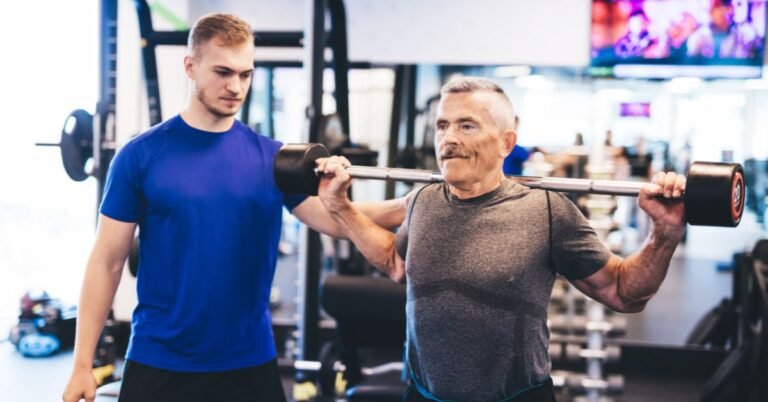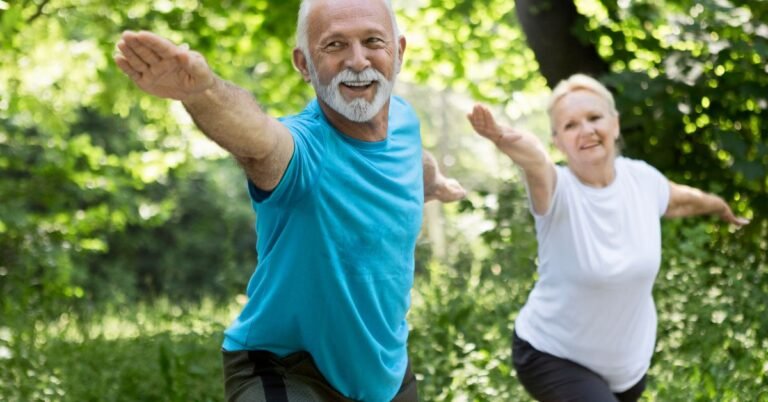The current Chief Medical Officer’s UK Physical Activity Guidelines recommend that adults, and older adults, are active every day. This activity should consist of either 150 minutes of moderate activity or 75 minutes of high or vigorous activity.
Moderate activity could be brisk walking, swimming or cycling (these are activities which cause you to be a bit short of breath, but you are still able to talk). High vigorous activity could be running or playing sports (a level of activity causing fast breathing and where you are unable to talk in full sentences).
Most people are aware of these guidelines, or at least aware that they should be active. However current self-reported activity levels tell us that around 1 in 3 men, and 1 in 2 women are not achieving these levels of activity. They also tell us that levels of physical activity reduce substantially with age. Bearing in mind these are self-reported, there is a chance they may be exaggerated too!
The benefits of older adults keeping active cannot be overlooked. 1 in 6 deaths in the UK is caused by physical inactivity (that equals the deaths caused by smoking). Although we all may know the benefits, let’s actually stop and consider the statistics. Being physically active reduces your risk of:
- All-cause mortality by 30% (that is ALL cause mortality- your total risk of death by ALL causes)
- Cardiovascular or heart disease by up to 35% (currently the biggest killer in western societies)
- Type 2 Diabetes by up to 45%
- Colon cancer by 30%
- Breast cancer by 20%
- Dementia by up to 30%
- Hip fractures by up to 68%
- Depression by up to 30%
An additional part of the Physical Activity Guidelines, which fewer people seem to be aware of, is the recommendation to be performing muscle strengthening exercises at least twice per week.
With the addition of this strength-based recommendation, an estimated 2 in 3 men and 4 in 5 women are not meeting the recommended aerobic and muscle strengthening guidelines advised for optimum health. Again, this is self reported and hence the true statistics are likely to be even worse!
This form of physical activity is one of the least likely to be performed regularly by older adults, especially by women. Yet, these are the very groups who could benefit the most from this type of exercise!
So what does strength training (resistance training) mean?
Muscle strengthening or resistance training is defined by the American College of Sports Medicine as “a form of physical activity that is designed to improve muscular fitness by exercising a muscle or muscle group against external resistance”.
The idea of muscle strengthening may sound scary, as if it is solely for young fit gym-goers who want to lift very heavy weights and ‘bulk up’. But, in reality, all muscle strength training means is asking your muscles to perform against an external resistance. This is something which we are constantly asking our bodies to do in functional day to day activities.
Think of every time we stand up from a chair, climb a set of stairs, pick up and carry heavy shopping or a lift a small child. All of these activities involve our muscles performing against an external resistance. The resistance is sometimes our own body weight, or sometimes an added load.
Healthy skeletal muscles allow us to perform all of the activities we want to in our day to day lives. They allow us to move and regulate our metabolism. The maintenance of healthy and strong muscles is protective for the rest of our bodies and our overall health. There is very good evidence to link muscle strength to overall physical functioning, improved quality of life and a lower risk of death at all ages!
In fact, muscle strengthening programmes have been shown to:
- Improve our physical performance and movement control of functional tasks
- Increase walking speed
- Increase bone density
- Increase independence in ageing
- Improve insulin metabolism
- Reduce visceral fat
- Lower blood pressure
- Lower levels of cholesterol
- Lower the risk of a number of chronic diseases: type 2 diabetes, cardiovascular diseases, osteoporosis
- Reduce the pain associated with a number of conditions: lower back pain, osteoarthritis and fibromyalgia
- Improve cognitive abilities
- Increase self-esteem and mood
In order to keep our muscles strong we have to be using them in an appropriate way on a regular basis. We have to be placing an appropriate demand upon our muscles for them to respond. This is why we all need to be performing regular muscle strengthening exercises.
In order to strengthen our muscle we need some external resistance. This can be achieved in various ways: body weight, free weights (such as dumbells, kettlebells), barbels, resistance machines, resistance bands. Or, just with household objects: big bottles of water, heavy books in a rucksack etc.
If this all sounds a bit new and scary, this website is going to provide older adults with numerous tips, guides and resources to either get started with strength training or improve and build up your current routines.




